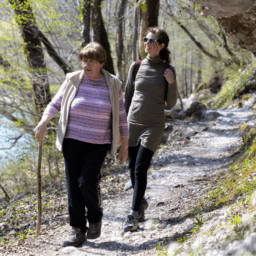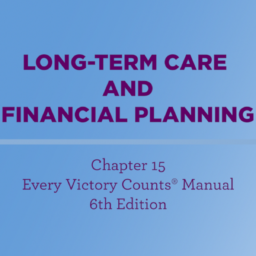Written by Jessica Shurer, LCSW, MSW
Contemplating and planning for the future can be a daunting task, especially when something like Parkinson’s keeps you from knowing exactly what to anticipate. Because of this, many people avoid exploring or having preemptive conversations around long-term care needs and options. However, sometimes this can lead to emotionally charged situations where you are faced with important decisions that need to be made more quickly than expected. Whether you are exploring professional in-home care or considering moving to a long-term care community, understanding the options in advance can help give you peace of mind, knowing you are better prepared for the “what ifs.”
Do All People with Parkinson’s Wind Up in a Facility? Are There Alternatives?
Many people with Parkinson’s can have their care needs met in their homes, but this varies greatly and depends on many factors. Take time to reflect on what “aging in place” would mean for you and your partner or family over time. Many people with Parkinson’s have increased needs as their symptoms change and progress; so, even if you are opting not to move to a long-term care facility, you may need to tap into additional support systems and resources to stay at home safely.
A good starting point would be to have an occupational therapist perform an in-home evaluation to determine if home safety modifications, such as installing a ramp, widening doorways, and adding grab bars, should be made. Think about whether such modifications are feasible in your home space, what those costs could look like, and what other safety measures might enhance your ability to live safely and independently with Parkinson’s.
Consider if you would be willing to bring outside care services into the house and understand what options are available.
Besides homecare and home healthcare, adult daycare is another alternative. Adult day centers can be a great addition or alternative to in-home care, as they offer socialization, activity engagement, and monitoring and provide some respite for family care partners.
 What Are the Options for Long-Term Care Communities in the US?
What Are the Options for Long-Term Care Communities in the US?
While the definitions can vary, it can be helpful to know the general options for long-term care community-based living:
#1 – Continuing care retirement communities (CCRCs)
CCRCs offer multiple levels of care, including independent living, assisted living, and skilled nursing, all within the same 272 community. For many CCRCs, you begin residence in the independent living area and move to the higher care levels with greater assistance and supervision as your care needs change. The policies and requirements vary regarding eligibility; it is common for CCRCs to require up-front “buy-in” fees and a physician’s report stating that you will most likely remain independent for a certain number of years.
#2 – Independent living communities
These are often planned communities geared for those over 55. There may be services and amenities offered, such as transportation, meal service, and exercise opportunities, and some will offer “à la carte” contracted in-home care. For the most part, however, you are typically expected to live independently and safely without extensive assistance.
#3 – Assisted living
This level of care is customarily for those who need some assistance with everyday tasks. Residents in assisted living frequently require help with bathing, medication management, household tasks like laundry and meal preparation, and overall safety monitoring, but they may not need much help with mobility or eating. Family care homes often offer an assisted-living level of care but in a more intimate setting, typically with fewer residents and in a house setting.
 #4 – Memory care
#4 – Memory care
These care units cater to people with more complex care needs specifically related to cognitive impairment or dementia. This can include delusions or paranoia, disorientation, wandering, agitation, and difficulty with task follow-through (for example, understanding how to get dressed).
#5 – Skilled nursing
This level of care is most appropriate for people who need help with three or more activities of daily living. Additionally, a person may benefit from a skilled nursing facility if they need to follow a more complex medication regimen, have multiple medical diagnoses, or have more involved care requirements, such as a feeding tube, tracheostomy, pressure wound, or catheter.
When It Comes to Finding the Right Long-Term Care Setting for Myself or my Loved One, Where Do I Start?
- Think about what level of care might be appropriate. Consider what types of assistance with daily tasks you need. Also, consider what may be needed down the road to avoid multiple residence moves.
- Reflect on your priorities for a long-term care community. Think through a few main aspects of a long-term care community that you would prefer and that will meet your needs, lifestyle, and comfort level. Factors to be taken into consideration might include location in relation to family members, cost, quality of food, activities offered, staff turnover, on-site allied health clinicians who have been specifically trained in Parkinson’s, and if other people with Parkinson’s reside there.
- Consult your healthcare team. Ask your physician for their professional input. This can be a neurologist, primary care physician, or whoever is the is most familiar with your symptoms, treatment plan, safety concerns, and care needs. Your allied health care team may contribute their valuable perspectives as well. If you are considering a move to long-term care, your primary Parkinson’s physician will benefit from having seen you recently in the event the facility asks them to complete paperwork.
- If possible, visit at least two communities. It would be beneficial to schedule a tour when you can ask questions and observe the staff and residents in action and view the living quarters, common areas, outdoor spaces, and surrounding neighborhood. Ask yourself if the residents look clean, happy, and engaged. Inquire about the staff’s experience with caring for people with Parkinson’s. Getting a feel for the living environment and services offered will help you decide which place is the best fit for you.
- Check out the reviews. Because government entities regulate assisted living and skilled nursing, you can often find lists of facilities and ratings online. Medicare has a nursing home comparison tool that can be found online, and many state- or county- level agencies, such as the state Department of Health & Human Services or Area Agencies on Aging, will provide credible information about reported quality of care at assisted living facilities and family care homes. Be aware that privately-owned care finders, social media-style review sites, and sites that accept paid advertising might not always project accurate assessments. You can also ask your friends, community members, and/or those in your Parkinson’s support groups if they would share their personal experiences with a long-term care community. Keep in mind that experiences and chemistry with facilities are subjective, and your perspective might be different from what you hear or read.
How Much Will It Cost My Family?
Depending on the level and amount of care needed and where you live, long-term care costs can vary greatly. It is surprising for many to learn that most health insurance, including Medicare, does not cover long-term care. However, it can be covered by Medicaid, long-term care insurance, or veterans’ benefits.
Organizations and county and state agencies sometimes offer limited in-home aide or respite programs or vouchers. However, most long-term care services, including facility- based and in-home care, are paid for privately. It can be financially feasible for some and cost-prohibitive for others. Financial advisors and elder law attorneys can also help you better understand what you can afford and explore asset protection options.
This Can Feel a Little Overwhelming at Times. Do You Have Any Other Recommendations When Making These Decisions?
Remember that you do not have to make these decisions alone. There are people who can support and advise you through the process, including family members and your healthcare team.
While acknowledging that it may not necessarily be fun, it is extremely helpful to have candid discussions about long-term care decisions.
Reflect together on your support system to address Parkinson’s care needs over time, including your primary care partner’s physical and mental health. The clinical social worker at your neurology clinic or local aging resources, such as a senior center, long-term care ombudsperson, or Department on Aging, can often share tips and resources. You can also consider hiring a professional geriatric care manager to help you navigate your options.
 As part of the planning process, it can also be extremely helpful to complete a Healthcare Power of Attorney and Living Will so that you can designate someone to make medical decisions on your behalf if needed and document personal wishes around medical interventions and care.
As part of the planning process, it can also be extremely helpful to complete a Healthcare Power of Attorney and Living Will so that you can designate someone to make medical decisions on your behalf if needed and document personal wishes around medical interventions and care.
For many, there is ultimately peace of mind that comes from embracing long-term care, especially when it’s planned openly and in advance. For example, it is common for families to share that the quality of their time together improves after a move to long-term care facility because now their shared time can be spent enjoying one another’s company instead of being focused on providing care. Another common circumstance we see when a family hires professional in-home care is that people with Parkinson’s are pleasantly surprised with the companionship they get from forming a relationship with the caregivers, while family care partners often report improved mental well-being from assistance with daily tasks and having time to recharge. You may be surprised at how much you thrive when you open yourself up to opportunities for interdependence.
We recognize that guilt and a sense of lost independence are associated with shifting to residence in a long-term care community or bringing in professional in-home care. This is often a transition for everyone involved, and it is normal and understandable to struggle with different emotions. When making these decisions, allow space to process your feelings while also being aware of your limitations and practical needs. The biggest factor in deciding what type of long-term care accommodation is right is determining what support is needed for your well-being and safety, and what is sustainable for you now and in the future.
Overall, what is important is that you know the options available so you can make informed decisions beforehand that will support your best possible quality of life.
Take Action
Long-term care planning is a difficult undertaking. After all, who is excited for the day when we can’t make decisions or are facing the end of our lives? However, by planning ahead with intention, you and your loved ones can rest assured that your needs and wishes are continually met. Prepare for your future now, as you live life to its fullest, so you can continue doing so for many years ahead.
About Jessica Shurer
Jessica Shurer is the Director of Patient and Care Partner Advocacy of CurePSP, whose mission and services are dedicated to the awareness, education, care, and cure of atypical Parkinsonism diseases—progressive supranuclear palsy, corticobasal degeneration, and multiple system atrophy. Prior to joining the team at CurePSP in October 2021, she served as the Center Coordinator & Clinical Social Worker of the Movement Disorders Center at the University of North Carolina at Chapel Hill, a Parkinson’s Foundation Center of Excellence and CurePSP Center of Care. She had been in this previous position since graduating from UNC Chapel Hill with her Master of Social Work in 2012. Her clinical and research interests include the psychosocial needs of navigating neurodegenerative disease, integrated healthcare models, and palliative and end-of-life care.













